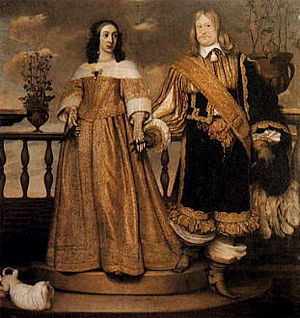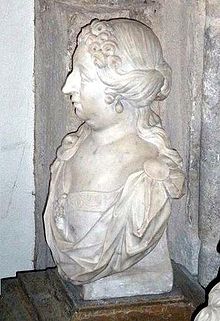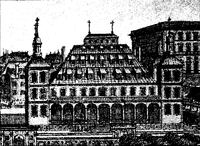- Countess Palatine Maria Eufrosyne of Zweibrücken
-
 Magnus Gabriel De la Gardie with his spouse Maria Eufrosyne of Pfalz-Zweibrücken, the sister of King Charles X of Sweden. Painting from 1653 by Hendrik Munnichhoven. The picture is filled with symbolic details: Magnus Grabriel is standing lower than his wife because she is sister of the king; their holding hands symbolizes fidelity; the bean in Maria Eufrosyne's hand shows that she is pregnant. The painting is regarded as one of the finest from the early Swedish baroque era.
Magnus Gabriel De la Gardie with his spouse Maria Eufrosyne of Pfalz-Zweibrücken, the sister of King Charles X of Sweden. Painting from 1653 by Hendrik Munnichhoven. The picture is filled with symbolic details: Magnus Grabriel is standing lower than his wife because she is sister of the king; their holding hands symbolizes fidelity; the bean in Maria Eufrosyne's hand shows that she is pregnant. The painting is regarded as one of the finest from the early Swedish baroque era. The Palace 'Makalös' (Peerless) of the De la Gardie family, right next door to The Royal Castle in Stockholm
The Palace 'Makalös' (Peerless) of the De la Gardie family, right next door to The Royal Castle in Stockholm
Countess Palatine Maria Eufrosyne of Zweibrücken (1625–1687) was a cousin and foster-sibling of Queen Christina of Sweden and sister of king Charles X of Sweden. She was also, after the accession of her brother Charles X on the throne (1654), a titular Royal Princess of Sweden.
Contents
Biography
Maria Eufrosyne was born to Count Palatine John Casimir of Zweibrücken and Princess Catherine of Sweden. Her family fled from Germany during the Thirty Years War (1622), and Maria and her siblings grew up in her mother's country; Maria herself was born in Sweden. She was initially brought up with Christina as her foster-sister, but soon, Christina was tutored separately, as she was given the same education as a man was given due to her position as a monarch.
Maria Eufrosyne was married to Christina's favourite Count Magnus Gabriel De la Gardie, on 7 March 1645 at the royal chapell at Tre Kronor (castle), in a marriage believed to have been arranged by Queen Christina. Tradition has regarded this as a triangle drama; Christina and Maria Eufrosyne were both believed to have been in love with Magnus, and in the end, Christina gave up the plans of marrying him herself, and gave him to her cousin with the words: I give to you what I can not have myself. A famous play has been written about this drama. It is not known how much of this legendary triangle drama is true, however. The marriage is not described as happy. The couple was forced to leave the court in 1653 after a disagreement with the queen, but could return the year after, when the brother of Maria Eufrosyne ascended to the throne.
At the coronation of her brother Charles X in 1654, Maria Eufrosyne was granted the rank and status of a Royal Princess of Sweden, although this was opposed by some parts of the nobility. Maria Eufrosyne did not use the title of Countess, but was generally referred to as "The Princess". She often received petitions on behalf of those who wanted her to speak to her husband on their account, and in the same fashion, she acted as mediator for her husband in the royal family, especially when he was out of favour with the monarch. In 1676, a witness in a witch trial inspired by the famous Gävle-Boy, Lisbeth Carlsdotter, tried to implicate her and her sister-in-law Maria Sofia in the trial, which was not taken seriously and fell back upon Carlsdotter, and instead lead to the trial being dissolved. A lot of the family's property was confiscated by the crown in 1682 during the 1680s reduction by King Charles XI. She became a widow in 1686, and died one year later.
Family
Married to Magnus Gabriel De la Gardie 7 March 1645. Out of eleven children, only three became adults, and only one (Hedvig Ebba), had issue; her grandson, however, died childless.
Issue
- Gustaf Adolf De la Gardie (1647–1695), unmarried, no issue.
- Catharina Charlotta De la Gardie (1655-1697), married to Otto Wilhelm Königsmarck, no issue.
- Hedvig Ebba De la Gardie (1657 - ), married to Carl Gustaf Oxenstierna (Eriksson), one son, who died childless.
Ancestry
References
- http://historiska-personer.nu/min-s/pacfa0838.html(Swedish)
- http://runeberg.org/sqvinnor/0297.html(Swedish)
- Jan Guillou: Häxornas försvarare (Defender of the witches) (Swedish)
- Svante Norrhem - Kvinnor vid maktens sida 1632-1772 (Women alongside power 1632-1772) (Swedish)
- Sven Axel Hallbäck - Läckö slott (Läckö palace)(Swedish)
- http://runeberg.org/sqvinnor/0297.html (Swedish)
- http://runeberg.org/famijour/1871/0069.html (Swedish)
- Anteckningar om svenska qvinnor, Wilhelmina Stålberg, P. G. Berg (Notes on Swedish women) (Swedish)
- Svenska Familj-Journalen (Swedish family journal) (Swedish)
Swedish princesses by birth The generations indicate descent form Gustav I, from the House of Vasa, and continues through the Houses of Palatinate-Zweibrücken, Holstein-Gottorp; and the Bernadotte, the adoptive heirs of the House of Holstein-Gottorp, who were adoptive heir of the Palatinate-Zweibrückens.1st generation Catharina, Countess of Ostfriesland · Cecilia, Margravine of Baden-Rodemachern · Anna Maria, Countess Palatine of Veldenz · Sophia, Duchess of Saxe-Lauenburg · Elizabeth, Duchess of Mecklenburg-Gadebusch2nd generation Princess Isabella · Princess Sigrid · Princess Anna · Princess Margareta Elizabeth · Princess Elizabeth Sabina · Catharina, Countess Palatine of Zweibrücken · Princess Maria · Princess Christina · Princess Maria Elizabeth, Duchess of Östergötland** · Princess Christina3rd generation Princess Anna Maria^ · Princess Catharina^ · Princess Catharina^ · Princess Anna Constance^ · Princess Anna Catharina Constance, Hereditary Countess Palatine of Neuburg^ · Princess Christina · Christina · Maria Eufrosyne, Countess Magnus Gabriel De la Gardie4th generation Princess Maria Anna Isabella^ · Princess Maria Anna Theresa^5th generation 6th generation none7th generation Sophia Albertina, Princess-Abbess of Quedlinburg8th generation Princess Louisa Hedwig9th generation 10th generation 11th generation 12th generation 13th generation 14th generation 15th generation *also a princess of Sweden by marriage
^also a princess of Poland and Lithuania by birth
**also a princess of NorwayCategories:- House of Palatinate-Zweibrücken
- Swedish princesses
- 1625 births
- 1687 deaths
- Countesses Palatine of Zweibrücken
- Alleged witches
Wikimedia Foundation. 2010.


